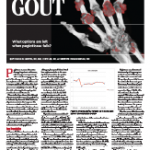Lastly, the study noted that in those who lost their response, a correlation was seen between higher antibody titers and rise in PUA, as well as increased infusion reactions as PUA began to rise. Nonetheless, it should be mentioned that again in this study all patients responded initially to pegloticase with a PUA of less than 6 mg/dL with the mean loss of response time being six weeks. Further, although this may have had some role in our patient’s lack of response, it is not fully explained by this, nor did he ever develop any sort of infusion reaction, as seen in those with high titers of antibodies.
Genetics have been shown to have an increasing role in hyperuricemia and gout. Based on several genome-wide association studies, numerous genes are known to be involved in the pathogenesis of hyperuricemia, most of which involve the uric acid transportasome.
The uric acid transportasome consists of a group of proteins that are coded by these particular genes as part of the renal urate transport system. There are several components of the transportasome each with multiple variants and single nucleotide polymorphisms that can lead to hyperuricemia.5 Known variants are included in Table 1. Each gene and their variants can lead to hyperuricemia in different ways through renal overload or renal under-excretion. For example, SLC2A9 codes for a glucose transporter (GLUT-9), which is involved in the reabsorption of filtered urate in the proximal tubules. In most genomic studies, this has been the most statistically significant genetic determinant of PUA.5 A loss of function mutation in this gene leads to renal hypouricemia.
Other studies have also shown that abnormal expression of GLUT-9 in articular chondrocytes may play a role in uric acid crystal deposition as well.6 Several more examples exist; however, these genomic studies have also shown variability between different ethnicities. In particular, for African Americans, mutations in ABCG2 and SLC22A12, two known genetic loci for hyperuricemia, may play an even larger role.7,8
A study done by Tin et al looking specifically at genetic-wide associations for African Americans showed a novel variant of SLC22A12, which codes for URAT1, that has an essential role in urate transport in the proximal tubules through the apical absorption of urate. This variant was shown to lead to substantially reduced urate transport.
Finally, variants of ABCG2 (an ATP binding cassette protein) have been shown to have a large effect on PUA in both men and African Americans.5,7 In particular, a single nucleotide polymorphism, which leads to a Glu131Lys amino acid substitution, has been shown to cause a 53% reduction in the rate of ABCG2-mediated urate transport.5


